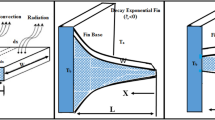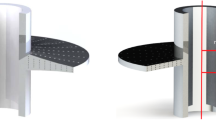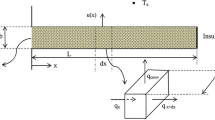Abstract
In this article, convection, radiation and internal heat generation for entropy generation in the moving exponential porous fin are investigated. We have considered fins of fixed dimension with insulated tip and convective coefficient at fin’s tip. The second law of thermodynamics for one-dimensional heat transfer is applied to study the entropy generation in the exponential porous fins. The shooting method is applied to solve the system numericaly. The amount of entropy generation depends on the porosity parameter, temperature distribution, and temperature ratio of the exponential porous fin which is observed. It is also observed that the highest generation of entropy exists at the fin’s base when the temperature difference is increased, at particular values of temperature ratio and porosity parameter. The data also reveal that the effect of porosity parameter on entropy generation number is substantially stronger than the influence of temperature ratio, with an increase in Porosity from 1 to 80 resulting in a 15-time increase in average entropy generation number. However, an increase in temperature ratio from 1.1 to 1.9 results an average of 30% increase in entropy generation number.









Similar content being viewed by others
Abbreviations
- A :
-
Area of fin’s surface m\(^2\)
- h :
-
Convection heat transfer coefficient W/m\(^2\) K
- L :
-
Fins length m
- q :
-
Internal heat generation W
- t :
-
Fin’s thickness m
- \(T_{\gamma }\) :
-
Temperature ratio
- U :
-
Speed of moving fin m/s
- x :
-
Direction along x-axis m
- \(C_{p}\) :
-
Specific heat of the material J/kg K
- \(k_\mathrm{eff}\) :
-
Effective thermal conductivity W/m K
- \(k_{f}\) :
-
Air thermal conductivity W/m K
- \(N_{r}\) :
-
Dimensionless radiation parameter
- \(R_{a}\) :
-
Rayleigh number \(\beta \,t^3\,(T-T_{a})/\lambda \,\nu \)
- \(T_{a}\) :
-
Ambient temperature K
- \(\alpha \) :
-
Fin shape parameter
- \(\beta \) :
-
Volume expansion coefficient K\(^{-1}\)
- \(\varepsilon \) :
-
Surface emissivity
- \(\lambda \) :
-
Thermal diffusivity of air m\(^2\)/s
- \(\varphi \) :
-
Porosity of the fin
- \(\theta _{a}\) :
-
Dimensionless ambient temperature
- g :
-
Gravitational acceleration m/s\(^{2}\)
- K :
-
Porous fins permeability Darcy
- P :
-
Fins perimeter m
- Q :
-
Dimensionless internal heat generation
- T :
-
Dimensional fin temperature K
- \({{\dot{m}}}\) :
-
Mass flow rate kg/s
- W :
-
Width of the fin m
- X :
-
Dimensionless coordinate
- \(D_{a}\) :
-
Darcy number K/t\(^2\)
- \(K_{s}\) :
-
Solid thermal conductivity W/m K
- Bi :
-
Biot number
- \(P_{e}\) :
-
Peclet number
- \(S_{h}\) :
-
Porosity parameter
- \(T_{b}\) :
-
Base temperature K
- \(\alpha ^*\) :
-
Dimensionless fin shape parameter
- \(\sigma \) :
-
Stefan–Boltzmann constant W/m\(^2\) K\(^4\)
- \(\nu \) :
-
Kinematic viscosity of air m\(^2\)/s
- \(\rho \) :
-
Density of material kg/m\(^3\)
- \(\theta \) :
-
Dimensionless local temperature
References
Khatami, S., Rahbar, N.: An analytical study of entropy generation in rectangular natural convective porous fins. Therm. Sci. Eng. Prog. 11, 142–149 (2019)
Dehghan, M., Valipour, M.S., Saedodin, S.: Microchannels enhanced by porous materials: heat transfer enhancement or pressure drop increment? Energy Convers. Manag. 110, 22–32 (2016)
Schmidt, E.F.: Wärmeübergang und Druckverlust in Rohrschlangen. Chem. Ing. Tech. 39(13), 781–789 (1967)
Duffin, R.: A variational problem relating to cooling fins. J. Math. Mech. 8, 47–56 (1959)
Dhar, P., Arora, C.: Optimum design of finned surfaces. J. Frankl. Inst. 301(4), 379–392 (1976)
Kiwan, S.: Effect of radiative losses on the heat transfer from porous fins. Int. J. Therm. Sci. 46, 1046–1055 (2007)
Kiwan, S., Zeitoun, O.: Natural convection in a horizontal cylindrical annulus using porous fins. Int. J. Numer. Heat Fluid Flow 18, 618–634 (2008)
Kiwanand, S., Al-Nimr, M.: Using porous fins for heat transfer enhancement. ASME J. Heat Transf. 123(4), 790–795 (2001)
Saedodin, S., Sadeghi, S.: Temperature distribution in long porous fins in natural convection condition. Middle-East J. Sci. Res. 13, 812–819 (2013)
Gorla, R.S.R., Bakier, A.Y.: Thermal analysis of natural convection and radiation in porous fins. Int. Commun. Heat Mass Transf. 38, 638–645 (2011)
Alshuraiaan, B., Khanafer, K.: The effect of the position of the heated thin porous fin on the laminar natural convection heat transfer in a differentially heated cavity. Int. Commun. Heat Mass Transf. 78, 190–199 (2016)
Oguntala, G.A., Sobamowo, M.G.: Galerkin’s method of weighted residual for a convective straight fin with temperature-dependent conductivity and internal heat generation. Int. J. Eng. Technol. 06, 432–442 (2016)
Sobamowo, M.G.: Thermal analysis of longitudinal fin with temperature-dependent properties and internal heat generation using Galerkin’s method of weighted residual. Appl. Therm. Eng. 99, 1316–1330 (2016)
Shateri, A.R., Salahshour, B.: Comprehensive thermal performance of convection-radiation longitudinal porous fins with various proles and multiple nonlinearities. Int. J. Mech. Sci. 136, 252–263 (2018)
Ma, J., Sun, Y., Li, B., Chen, H.: Spectral collocation method for radiative-conductive porous fin with temperature dependent properties. Energy Convers. Manag. 111, 279–288 (2016)
Oguntala, G., Sobamowo, G., Abd-Alhameed, R., Noras, J.: Numerical investigation of inclination on the thermal performance of porous fin heatsink using pseudospectral collocation method. Karbala Int. J. Mod. Sci. 5 (2019)
Ma, J., Sun, Y., Li, B.: imulation of combined conductive, convective and radiative heat transfer in moving irregular porous fins by spectral element method. Int. J. Therm. Sci. 118, 475–487 (2017)
Oguntala, G., Abd-Alhameed, R., Sobamowo, G., Danjuma, I.: Performance, thermal stability and optimum design analyses of rectangular fin with temperature-dependent thermal properties and internal heat generation. J. Comput. Appl. Mech. 49, 37–43 (2018)
Oguntala, G., Abd-Alhameed, R.A.: Haar wavelet collocation method for thermal analysis of porous fin with temperature-dependent thermal conductivity and internal heat generation. J. Appl. Comput. Mech. 3, 185–191 (2017)
Torabi, M., Yaghoobi, H.: Series solution for convective-radiative porous fin using differential transformation method. J. Porous Media 16, 341–349 (2013)
Moradi, A., Hayat, T., Alsaedi, A.: Convection-radiation thermal analysis of triangular porous fins with temperature-dependent thermal conductivity by DTM. Energy Convers. Manag. 77, 70–77 (2014)
Torabi, M., Yaghoobi, H., Aziz, A.: Analytical solution for convective-radiative continuously moving fin with temperature-dependent thermal conductivity. Int. J. Thermophys. 33, 924–941 (2012)
Coskun, S.B., Atay, M.T.: Fin efficiency analysis of convective straight fins with temperature-dependent thermal conductivity using variational iteration method. Appl. Therm. Eng. 28, 2345–2352 (2008)
Singla, R.K., Das, R.: Application of decomposition method and inverse prediction of parameters in a moving fin. Energy Convers. Manag. 84, 268–281 (2014)
Singla, R.K., Das, R.: Adomian decomposition method for a stepped fin with all temperature-dependent modes of heat transfer. Int. J. Heat Mass Transf. 82, 447–459 (2015)
Rashidi, M.M., Erfani, E.: New analytical method for solving Burgers and nonlinear heat transfer equations and comparison with HAM. Comput. Phys. Commun. 180, 1539–1544 (2009)
Domairry, G., Ahangari, M., Jamshidi, M.: Exact and analytical solution for nonlinear dispersive K(m, p) equations using homotopy perturbation method. Phys. Lett. A 368(3–4), 266–70 (2007)
Bhanja, D., Kundu, B., Mandal, P.K.: Thermal analysis of porous pin fin used for electronic cooling. Procedia Eng. 64, 956–965 (2013)
Singh, K., Das, R., Kundu, B.: Approximate analytical method for porous stepped fins with temperature-dependent heat transfer parameters. J. Thermophys. Heat Transf. 30, 661–672 (2016)
Cucu, E., Cucu, P.M.: A successful application of homotopy perturbation method for efficiency and effectiveness assessment of longitudinal porous fins. Energy Convers. Manag. 93, 92–99 (2015)
Deghan, M., Nesaz, Z.A., Pourrajabian, A., Rashidi, S.: On the forced convective flow inside thermal collectors enhanced by porous media: from macro to micro-channels. Int. J. Numer. Methods Heat Fluid Flow (2021)
Deghan, M.: Effects of heat generations on the thermal response of channels partially filled with Non-Darcian porous materials. Transp. Porous Med. 110(3), 461–482 (2015)
Deghan, M., Valipour, M.S., Saedodin, S.: Analytical study of heat flux splitting in micro-channels filled with porous media. Transp. Porous Med. 109(3), 571–87 (2015)
Dehghan, M., Valipour, M.S., Saedodin, S.: Conjugate heat transfer inside microchannels filled with porous media: an exact solution. J. Thermophys. Heat Trans. 30(4), 814–824 (2016)
Mahian, O., et al.: A review of entropy generation in nanofluid flow. Int. J. Heat Mass Transf. 65, 514–532 (2013)
Mahian, O., Mahmud, S., Wongwises, S.: Entropy generation between two rotating cylinders with magnetohydrodynamic flow using nanofluids. J. Thermophys. Heat Transf. 27(1), 161–169 (2012)
Bejan, A.: Entropy generation minimization: the new thermodynamics of finite-size devices and finite-time processes. J. Appl. Phys. 79(3), 1191–1218 (1996)
Bejan, A.: Method of entropy generation minimization, or modeling and optimization based on combined heat transfer and thermodynamics. R. Gen. Therm. 35(418–419), 637–646 (1996)
Bejan, A.: Fundamentals of exergy analysis, entropy generation minimization, and the generation of flow architecture. Int. J. Energy Res. 26(7) (2002)
Poulikakos, D., Bejan, A.: Fin geometry for minimum entropy generation in forced convection. J. Heat Transf. 104(4), 616–623 (1982)
Rahbar, N., Asadi, A., Fotouhi-Bafghi, E.: Performance evaluation of two solar stills of different geometries: tubular versus triangular: experimental study, numerical simulation, and second law analysis. Desalination 443, 44–55 (2018)
Mahmud, S., Fraser, R.A.: Second law analysis of heat transfer and fluid flow inside a cylindrical annular space. Exergy Int. J. 2, 322–329 (2002)
Kundu, B., Das, R., Lee, K.S.: Differential transform method for thermal analysis of exponential fin under sensible and altent heat transfer. Procedia Eng. 127, 287–294 (2015)
Rahbar, N., Gharaiian, A., Rashidi, S.: Exergy and economic analysis for a double slope solar still equipped by thermoelectric heating modules-an experimental investigation. Desalination 420, 106–113 (2017)
Aliphanah, F., Rahbar, N.: CFD simulation and second law analysis of weir-type cascade solar stills with different number and dimensions of steps. Desalin. Water Treat. 104, 15–27 (2018)
Taufiq, B.N., et al.: Second law analysis for optimal thermal design of radial fin geometry by convection. Appl. Therm. Eng. 27, 1363–1370 (2007)
Abu-Hijleh, B.A., Abu-Qudais, M., Abu Nada, E.: Numerical prediction of entropy generation due to natural convection from a horizontal cylinder. Energy Int. J. 24, 327–333 (1999)
Cui, P., Cai, M., Yang, D.: Effect of defected behavior on interfacial heat transferring performance for HP-LED packaging based on entropy generation analysis. In: 19th International Conference on Electronic Packaging Technology (ICEPT), pp. 423–427 (2018)
Aziz, A., Makinde, O.D.: Heat transfer and entropy generation in a two-dimensional orthotropic convection pin fin. Int. J. Exergy 7(5), 579–59 (2010)
Turkyilmazoglu, M.: Exact solutions to heat transfer in straight fins of varying exponential shape having temperature dependent properties. Int. J. Therm. Sci. 55, 69–79 (2012)
Hatami, M., Hasanpour, A., Ganji, D.D.: Heat transfer study through porous fins (Si3N4 and AL) with temperature-dependent heat generation. Energy Convers. Manag. 74, 9–16 (2013)
Hatami, M., Ganji, D.D.: Thermal and flow analysis of microchannel heat sink (MCHS) cooled by Cu–water nanofluid using porous media approach and least square method. Energy Convers. Manag. 78, 347–358 (2014)
Hatami, M., Ganji, D.D.: Investigation of refrigeration efficiency for fully wet circular porous fins with variable sections by combined heat and mass transfer analysis. Int. J. Refrig. 40, 149–154 (2014)
Hatami, M., Ganji, D.D.: Thermal behavior of longitudinal convective-radiative porous fins with different section shapes and ceramic materials (SiC and Si3N4). Ceram. Int. 40, 6765–6775 (2014)
Turkyilmazoglu, M.: Efficiency of heat and mass transfer in fully wet porous fins: exponential fins versus straight fins. Int. J. Refrig. 46, 158–164 (2014)
Turkyilmazoglu, M.: Stretching/shrinking longitudinal fins of rectangular profile and heat transfer. Energy Convers. Manag. 91, 199–203 (2015)
Ahmad, I., Zahid, H., Ahmad, F., Raja, M.A.Z., Baleanu, D.: Design of computational intelligent procedure for thermal analysis of porous fin model. Chin. J. Phys. 59, 641–655 (2019)
Das, R., Ooi, K.: Predicting multiple combination of parameters for designing a porous fin subjected to a given temperature requirement. Energy Convers. Manag. 66, 211–219 (2013)
Cengel, Y.A., Boles, M.A.: Thermodynamics: An Engineering Approach. McGraw-Hill, New York (2002)
Moran, M.J., et al.: Fundamentals of Engineering Thermodynamics. Wiley, West Sussex (2010)
Author information
Authors and Affiliations
Additional information
Publisher's Note
Springer Nature remains neutral with regard to jurisdictional claims in published maps and institutional affiliations.
Rights and permissions
About this article
Cite this article
Din, Z.U., Ali, A. & Zaman, G. Entropy generation in moving exponential porous fins with natural convection, radiation and internal heat generation. Arch Appl Mech 92, 933–944 (2022). https://doi.org/10.1007/s00419-021-02081-2
Received:
Accepted:
Published:
Issue Date:
DOI: https://doi.org/10.1007/s00419-021-02081-2




